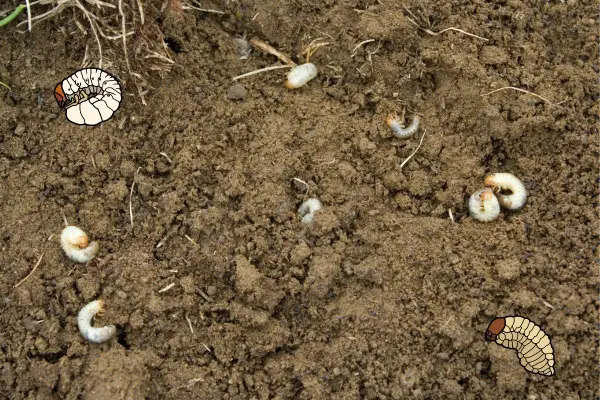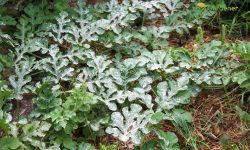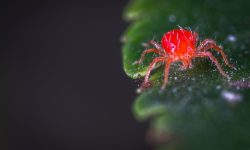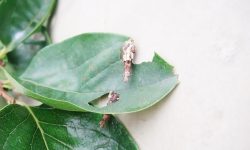Grub worms are the larvae of certain beetles, including Japanese beetles, carpet beetles, and June bugs. They live under the soil and feed on the roots of plants. This feeding can cause extensive damage to lawns and gardens.
Gardeners or lawn owners who had to deal with them know, grubworms are a pain. They’re annoying, and they can wreak havoc on your yard. It’s important to identify what type of beetle they turn into in order to protect your plants.
Do grub worms turn into June bugs? Some species of scarab beetles, including the June bug, have larvae referred to as grub worms, but not all grub worms transform into June bugs. In fact, June bugs are just one type of beetle that can emerge from the soil as adults.
Wilting and yellowing of leaves are common signs of grubworm presence in the garden. If you notice such signs it’s important to take action quickly. See the pics in the section below to help you identify the pest in your garden!
Table of Contents
What Type of Beetle Grub Worm Turn Into
It is important to identify what type of beetle your grubworm will turn into for pest control, as different species have different life cycles and require different treatments.
1. Green June Beetle
June bug is named June as they emerge in May or June from the larva. Like other grubworms, they spend the larval stage under the spill. Not all grubworms turn into June bugs. The Green This species of scarab beetle is found in North America. This bug is large in size with bright green color. It can also be identified by its distinctive loud buzzing sound.
It invades gardens and fields, where it can feed easily a variety of plants and leaves. The Green June Beetle has become an increasingly common pest in recent years, due to its ability to reproduce and spread across large areas quickly. It plays an important role in the environment by helping to break down organic matter into fertilizer for plants.
2. Japanese Beetle
Japanese Beetle is native to Japan and was accidentally introduced into the United States in 1916. Now it has spread throughout much of the country, causing extensive damage to agricultural crops, ornamental plants, and turf grasses.
The Japanese Beetle has a wide range of hosts that it feeds on, making it difficult to control without using chemical or biological methods. Understanding the life cycle of this pest and its behavior can help homeowners and farmers better protect their crops from its destructive effects.
3. Weevile or Snoutbug
The weevil snoutbug is a type of beetle belonging to the family Curculionidae. This insect can be found in many parts of the world, including Europe, Asia, and North America. It has a long snout-like mouth part which it uses to feed on plant material.
This makes it an important pest species, as it can cause considerable damage to crops and other vegetation. The overpopulation of this insect can have a negative impact on biodiversity as it competes with native species for food resources.

Do Grub Worms Turn Into June Bugs
Yes, in some cases grub worms can turn into June bugs, also called May beetles or scarab beetles. Grub worms are the larvae of several species of beetle, including the June bug. The grub worm stage typically lasts for two to three years before the insects emerge from the soil as adults.
June bugs have a characteristic “C”-shaped body and are brownish-black in color with pale yellow stripes on their wings. They range in size from 0.5 inches to 1 inch long and are commonly found in gardens, fields, and lawns throughout North America. During early summer they can often be seen flying around outdoor lights at night.
The adult June bugs feed on plant foliage, flowers, and fruit, and their larvae (grub worms) eat plant roots or decaying organic matter in the soil. Grub worms have a cream-colored body with a brown head and three pairs of legs near their head end. They grow up to 1 inch long during this stage before burrowing back down into the ground to pupate and then emerge as adult beetles after two to three years underground.
It is important to note that not all grub worms transform into June bugs – there are many species of beetle whose larvae are referred to as grub worms but do not turn into June bugs when they reach adulthood. In addition, some species of beetle that look similar to June bugs also have grubs that never transform into adult beetles so it is important to confirm which type of insect you have before assuming it is a June bug.
The Life Cycle of a Grub Worm
Grubworms have a life cycle that lasts about one year. The life cycle of a Grub worm begins when the adult female beetle lays eggs in the soil. The eggs hatch into larvae, which are known as grub worms. They feed on the roots of plants and grow, pupate, and emerge as adult beetles. The life cycle of grubworms has several stages of development.
Stage-1: At first, grub worms are small and cream-colored, with a yellowish-brown head.
Stage-2: As they get older, they become larger and darker in color, with darker heads. The grub worms live in the soil for several weeks or months, feeding on plant roots and growing.
Stage-3: Eventually, they pupate and transform into adult beetles. The young beetles emerge from the soil after passing the larval stage in the late spring or early summer months. The females will mate to lay eggs and start the cycle over again.
Differences Between Grub Worms and June Bugs
While both grub worms and June bugs are members of the scarab beetle family, there are several key differences between the two.
- Grub worms are the larvae of scarab beetles, while June bugs are the adult form of certain species of scarab beetles.
- Grub worms are typically white or cream-colored, while June bugs are brown or green and have a hard exoskeleton.
- Grub worms feed on the underground part of plants such as the roots of grass and other plants, while June bugs feed on the upper parts such as leaves of trees, shrubs, and branches of plants.
- June bugs are primarily active at night, while grub worms are active during the day.
Why Do Grubworms Turn into June Bugs
Grubworms turn into June bugs because of the beetle’s life cycle. The cycle begins with the female beetle laying eggs in the soil. When these eggs hatch, the emerging larvae are known as grub worms. The grub worms live in the soil for several weeks or months, feeding on plant roots and growing. Eventually, they pupate and transform into adult beetles.
Now they are grown up and they can no longer remain in the soil. They emerge as adult beetles and fly away, looking for food, shelter, and mates. Depending on the species, these adult beetles can be called June bugs, carpet beetles, or Japanese beetles. This is why Grub worms turn into June bugs.
Common Misconceptions About Grub Worms
There are many misconceptions about grub worms, including the belief that they transform into June bugs. While it is true that some species of scarab beetles, including the June bug, have larval stages that are referred to as grub worms, not all grub worms transform into June bugs. Not all species of scarab beetles have the same life cycles and they emerge as adults at different times of the year.
Another common misconception is that grubworms only feed on the roots of the grass. They are dangerous to the roots of other plants, including vegetables and flowers.
How to Tell If a Grubworm Has Turned Into a June Bug
Grub worms and June bugs look completely different. Grubworms are small and white, while June bugs are brown or black. To tell if a grubworm has turned into a June bug, check the area where you think the grubworm was, and look for an adult beetle. If you see an adult beetle, chances are it is the transformed grubworm.
Conclusion
Grub worms are the larvae of certain beetles, including Japanese beetles, carpet beetles, and June bugs. It’s important to know what species of grubworms are invading your garden. In this way, you can take steps to control them. If you leave this pest untreatable it will damage your garden badly.
References:
- “The Life Cycle of the June Bug” by Sciencing
- “June Beetles in the Landscape” by the University of California Statewide Integrated Pest Management Program: https://www2.ipm.ucanr.edu/agriculture/landscape-and-turf/june-beetles-in-the-landscape/
- “White Grubs and Their Management” by the University of Minnesota Extension: https://extension.umn.edu/insects-infest-homes/white-grubs-and-their-management
- “Japanese Beetle and Its Grubs” by the Missouri Botanical Garden: https://www.missouribotanicalgarden.org/gardens-gardening/your-garden/help-for-the-home-gardener/advice-tips-resources/pests-and-problems/insects/beetles/japanese-beetle-and-its-grubs.aspx
- “Grubs” by the University of Illinois Extension: https://extension.illinois.edu/grubs




![How Long Does Sevin Dust Last? [Minimum Time For Working Fast]](https://gardenerpick.com/wp-content/uploads/2022/01/how-long-does-sevin-dust-last-250x150.jpg)
![What Do Inchworms Turn Into? [Life Cycle]](https://gardenerpick.com/wp-content/uploads/2022/07/What-Do-Inchworms-Turn-Into-250x150.jpg)
![Why Do Worms Come Out When It Rains? [5 Reasons To Know]](https://gardenerpick.com/wp-content/uploads/2022/07/Why-Do-Worms-Come-Out-When-It-Rains-250x150.jpg)